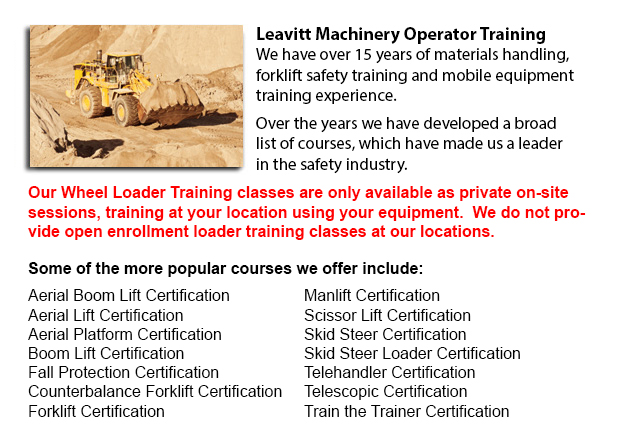
Saskatoon Wheel Loader Operator Training - In order to lift considerable cargo, industrial cranes utilize pulleys and levers. Before, Roman people used cranes so as to construct huge monuments making the origin of these machinery at least two thousand years ago. Many Medieval churches utilized cranes in their construction as well as the Egyptians might have used them when building the pyramids.
Modern cranes could either be complex or simple, based on the nature of the application they can perform. For instance, mobile cranes are rather simple units. A steel truss and even a telescopic boom mounts its movable platform. A system of levers or pulleys raises the boom and there is often a hook hanging. These cranes are frequently meant for earthmoving or demolition by changing the hook out with another piece of device like for example a wrecking ball or a bucket. Telescopic cranes have a series of hydraulic tubes which fit together to form the boom. These models can even be mobile.
Both traditional or specialized wheels can be designed for railroad track or caterpillar track enabling these boom trucks to be able to move on upaved and uneven surfaces.
Truck mounted and rough terrain cranes are mobile as well. Outriggers are situated on the truck mounted unit in order to increase stability, while rough terrain cranes include a base which tends to resemble the bottom of a 4-wheel drive. These cranes are equipped in order to function on rough surface making them perfect in the construction trade for instance.
Normally used on railroads and in ports, the Gantry crane can transport and unload large containers off ships and trains. Their bases consist of very big crossbeams that run on rails in order to lift containers from one location to another. A portainer is a special kind of gantry that transfers materials onto and off of ships in particular.
Floating cranes are mounted on barges or pontoons and are another essential piece of equipment essential to the shipping business. As they are situated in water, they are designed for different services including building bridges, salvaging ships and port construction. Floating cranes can handle really heavy loads and containers and similar to portainers, they could likewise unload ships.
Loader cranes comprise hydraulic driven booms which are fitted onto trailers to be able to load merchandise onto a trailer. The jointed parts of the boom can be folded down when the machine is not in being used. This particular type of crane can be also considered telescopic since one section of the boom could telescope for more versatility.
Stacker cranes are normally found in automated warehouses. They tend to follow an automatic retrieval system and can work through remote. These cranes are equipped together with a forklift apparatus and can be seen in big automated freezers, obtaining or stacking foodstuff. Using this type of system enables employees to remain out of that cold environment.
Tower cranes, normally the tallest type, usually do not have a movable base. They should be assembled part by part. Their base is similar to a long ladder with the boom at right angles to the base. These cranes specialize in the construction of tall buildings and are usually affixed to the inside of the building itself all through the construction period.
-
Saskatoon Telehandler License
Saskatoon Telehandler License - The telescopic handler or telehandler is a frequently utilized machine in agricultural and industrial applications. This particular equipment is similar in appearance to a forklift and even functions in a similar way,... More -
Saskatoon Zoom Boom Ticket
Saskatoon Zoom Boom Ticket - Zoom Boom Training focuses on correctly training prospective operators on variable reach forklifts. The training objectives consist of gaining the knowledge of the machine's physics and to define the job of the operator.... More -
Saskatoon Forklift Operator Training
Saskatoon Forklift Operator Training - In North America, lift truck operator training is needed in order to prevent workplace injuries and accidents. Particular lift truck training will be provided to offer forklift operators driver training. The saf... More -
Saskatoon Forklift Certification Schools
Saskatoon Forklift Certification Schools - Forklift Certification is mandatory in North America. Hence, forklift training programs are essential both for businesses and for individuals seeking jobs in industries as forklift operators. Forklift traini... More -
Saskatoon Telehandler Training Courses
Saskatoon Telehandler Training Courses - Employers are responsible for making certain that their operating personnel and supervisors are trained to work competently utilizing telehandler machines. The competence level of staff must be assessed. If de... More -
Saskatoon Boom Lift Training
Saskatoon Boom Lift Training - Aerial platforms or likewise known as elevated work platforms are devices that enable workers to perform tasks and duties at elevated heights that will not be otherwise accessible. There are many aerial lifts available... More -
Crane / Overhead Crane / Self-Erect Crane / Truck Mounted Crane / Hydraulic Cranes Training in Saskatoon
Overhead cranes are likewise referred to as bridge cranes. They are a type of crane which comprises a line and hook device that runs along a horizontal beam which runs along two widely separated rails. Several overhead cranes can be found within a lo... More -
Saskatoon Heavy Equipment Training Programs
Saskatoon Heavy Equipment Training Programs - At any given construction site, there are usually different types of machinery which are ready to be used. These light and heavy machinery require both operators to run them and mechanics to fix them. Tra... More

Forklift Certification Saskatoon
TOLL FREE: 1-888-254-6157
Saskatoon, Saskatchewan
forkliftcertificationsaskatoon.com
Email Us
About Us


